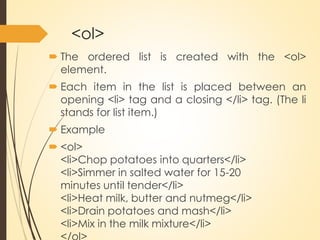Listing in web development and uses
- 1. LISTS Preseneted by: Nabin jamkatel
- 2. Introduction ? There are lots of occasions when we need to use lists. ? HTML provides us with three different types: ?Ordered lists are lists where each item in the list is numbered. ? Unordered lists are lists that begin with a bullet point(rather than characters that indicate order). ?Definition lists are made up of a set of terms along with the definitions for each of those terms.
- 3. <ol> ? The ordered list is created with the <ol> element. ? Each item in the list is placed between an opening <li> tag and a closing </li> tag. (The li stands for list item.) ? Example ? <ol> <li>Chop potatoes into quarters</li> <li>Simmer in salted water for 15-20 minutes until tender</li> <li>Heat milk, butter and nutmeg</li> <li>Drain potatoes and mash</li> <li>Mix in the milk mixture</li>
- 4. Examples ? <ol start="50"> <li>Coffee</li> <li>Tea</li> <li>Milk</li> </ol> ? <ol type="I" > <li>Coffee</li> <li>Tea</li> <li>Milk</li> </ol>
- 5. <ul> ? The unordered list is created with the <ul> element ? Example ? <ul> <li>1kg King Edward potatoes</li> <li>100ml milk</li> <li>50g salted butter</li> <li>Freshly grated nutmeg</li> <li>Salt and pepper to taste</li> </ul>
- 6. Definition Lists ?The definition list is created with the <dl> element and usually consists of a series of terms and their definitions. ?Inside the <dl> element you will usually see pairs of <dt> and <dd> elements ?<dt> is used to contain the term being defined (the definition term). ?<dd> is used to contain the definition.
- 7. Example ? <dl> <dt>Sashimi </dt> <dd>Sliced raw fish that is served with condiments such as shredded daikon radish or ginger root, wasabi and soy sauce</dd> <dt>Scale</dt> <dd>A device used to accurately measure the weight of ingredients</dd> <dd>A technique by which the scales are removed from the skin of a fish</dd> <dt>Scamorze</dt> <dd>An Italian cheese usually made from whole cow's milk (although it was traditionally made from buffalo milk) </dd> </dl>







